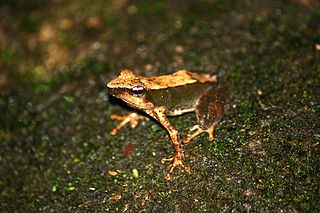
Micrixalus is a genus of frogs from that are endemic to the Western Ghats in India. They are monotypic within the family Micrixalidae. Before being raised to the family level they were classified as the subfamily Micrixalinae within Ranidae. Micrixalus frogs are popularly known as "dancing frogs" due to their peculiar habit of waving their feet to attract females during the breeding season. Dancing frogs are extremely vulnerable as their habitat is severely threatened.

Micrixalus fuscus is a species of small frog found in dense forested hill streams in the Western Ghats of India. M. herrei was formerly synonymized within this species.

Micrixalus saxicola is a species of frog in the family Micrixalidae, found in forest streams in the Western Ghats of India.

Micrixalus elegans is a species of frog in the family Micrixalidae. It is endemic to the Western Ghats, India, and occurs between the Palakkad Gap and Goa Gap in the states of Kerala and Karnataka. Micrixalus elegans is one of the Micrixalus species showing "foot-flagging" behaviour, hence the common name elegant dancing frog has been proposed. Other common names include elegant torrent frog and elegant bush frog.

Micrixalus kottigeharensis is a species of frog in the family Micrixalidae. It is endemic to the Western Ghats in Karnataka, India. It is one of the "Top 100 Evolutionarily Distinct and Globally Endangered (EDGE) Amphibians". The specific name means "from Kottigehara".

Micrixalus adonis is a newly described species of frogs in the family Micrixalidae. It is endemic to the Western Ghats in southern India, restricted to areas between the Palghat Gap and Shencottah Gap. Common name beautiful dancing frog has been proposed for this species, in reference to its vividly rich colouration.

Micrixalus frigidus is a species of frogs in the family Micrixalidae. It is endemic to the Western Ghats, India. Its natural habitats are subtropical or tropical moist lowland forest and rivers.

Micrixalus herrei is a newly redescribed species of frog in the family Micrixalidae. Originally described in 1942, it was synonymized with M. fuscus in 1984. However, morphological differences as well as DNA evidence confirm this species to be valid. It is endemic to the Western Ghats, India, and occurs south of the Shencottah Gap in Kerala and Tamil Nadu states. The common name Kallar dancing frog has been proposed for this species, in reference to Kallar, Trivandrum, its type locality.
Micrixalus kodayari, also known as the kodayar dancing frog, is a species of frogs in the family Micrixalidae. It is endemic to the Western Ghats, India.

Micrixalus mallani is a species of frogs in the family Micrixalidae. It is endemic to the Western Ghats, India.

Micrixalus nelliyampathi is a newly described species of frog in the family Micrixalidae. It is endemic to the Western Ghats, India.

Micrixalus niluvasei is a newly described species of frogs in the family Micrixalidae. It is endemic to the Western Ghats, India.
Micrixalus nigraventris is a species of frogs in the family Micrixalidae. It is endemic to the Western Ghats, India.
Micrixalus sali is a species of frogs in the family Micrixalidae. It is endemic to the Western Ghats, India.
Micrixalus sairandhri is a species of frogs in the family Micrixalidae. It is endemic to India.

Micrixalus specca is a species of frogs in the family Micrixalidae. It is endemic to the Western Ghats, India.
Micrixalus spelunca is a species of frogs in the family Micrixalidae. It is endemic to the Western Ghats, India.

Micrixalus uttaraghati is a species of frogs in the family Micrixalidae. It is endemic to the Western Ghats, India.

Nyctibatrachus pulivijayani, or Vijayan's night frog, is a species of night frogs, family Nyctibatrachidae. The frog is endemic to the Western Ghats, India, and is only known from its type locality, Pandipath, in the Agasthyamalai Hills, Thiruvananthapuram district, Kerala. Smaller than a human fingernail, it is among the smallest frog species in the world. Nyctibatrachus pulivijayani is part of a genus that evolved in India around 70–80 million years ago. The species of frog was discovered by scientists from the University of Delhi.
Indosylvirana indica, the Indian golden-backed frog, is a species of frog in the family Ranidae. It was formerly considered as conspecific with Indosylvirana temporalis but was found to be a distinct species in a 2014 study.















